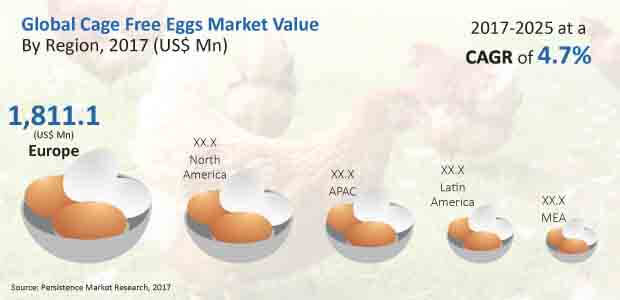Cage Free Eggs Market Segmented By Brown, White Color in Medium, Large, Extra Large, Jumbo Size
Industry: Food and Beverages
Published Date: August-2017
Format: PPT*, PDF, EXCEL
Delivery Timelines: Contact Sales
Number of Pages: 213
Report ID: PMRREP11086
The cage free eggs market in Europe is estimated to be valued at about US$ 1,800 Mn by the end of 2017 and is expected to increase at a CAGR of 5.4% over the forecast period. The Europe cage free eggs market is expected to be valued at more than US$ 2,700 Mn by the end of 2025. The market in the region is expected to represent an absolute $ opportunity of more than US$ 80 Mn in 2017 over 2016 and an incremental $ opportunity of more than US$ 950 Mn between 2017 and 2025.
The market in Poland is estimated to be valued at a little more than US$ 320 Mn by 2017 end and is expected to increase at a CAGR of 5.5% over the forecast period. The Poland cage free eggs market is expected to be valued at more than US$ 490 Mn by the end of 2025. The cage free eggs market in Poland is expected to represent an absolute $ opportunity of US$ 16.0 Mn in 2017 over 2016 and an incremental $ opportunity of US$ 172.1 Mn between 2017 and 2025.

The concern for animal welfare has increased significantly in the past decade. With animal organizations setting up and campaigning against poultry and egg manufacturers, many companies are taking up initiatives for farm animal welfare. Cage free eggs market in the Europe region has witnessed significant growth after egg manufacturers have collaborated with animal welfare organizations.
It is noticed that the lifestyle of hens affects their health and alters the nutrition status of the eggs. Studies have reported that cage free eggs have larger and deep orange yolks, which are known to have more fatty acid levels but no effect on the levels of cholesterol and are also tastier as compared to the conventional cage laid eggs.
Sensitivity towards animal welfare is relatively high in the Europe market than developing and underdeveloped markets. Despite increased cost of production and maintenance of cage free eggs, big manufacturers are compelled to cater to the demand of retailers.
This demand has prompted manufacturers to opt for cage free egg manufacturing rather than conventional caged production. Increasing pressure by the government on manufacturers to switch to the production of cage free eggs is also boosting the growth of the market.
Cage free eggs production is very expensive. It involves owning a huge stretch of land and shelling out a large amount of money for labor costs. The hens in a cage occupy a relatively small area in caged production. However, in cage free production hens require free open space and maintenance of an environment that the hens are habituated to.
Cage free eggs production is expected to require ten times the labor to look after the hens that naturally roam about in the open land. Due to the freedom given to the hens to roam about in the farms and agroforestry areas, there are chances of losing hens and also the eggs they lay are not confined to a particular spot.
Hens reared in battery cages are mostly injected with growth hormones and other supplements often provided with feed that is nutritious but not naturally consumed by hens. Such hens produce more eggs to cater to the daily requirements in the market. These are easy to produce than cage free eggs, which are produced in lesser numbers and sold at a much higher price in the retail market. All these factors are hampering the growth of the Europe cage free eggs market.
| Attribute | Details |
|---|---|
|
By Color |
|
|
By Size |
|
|
By Region |
|
To know more about delivery timeline for this report Contact Sales
